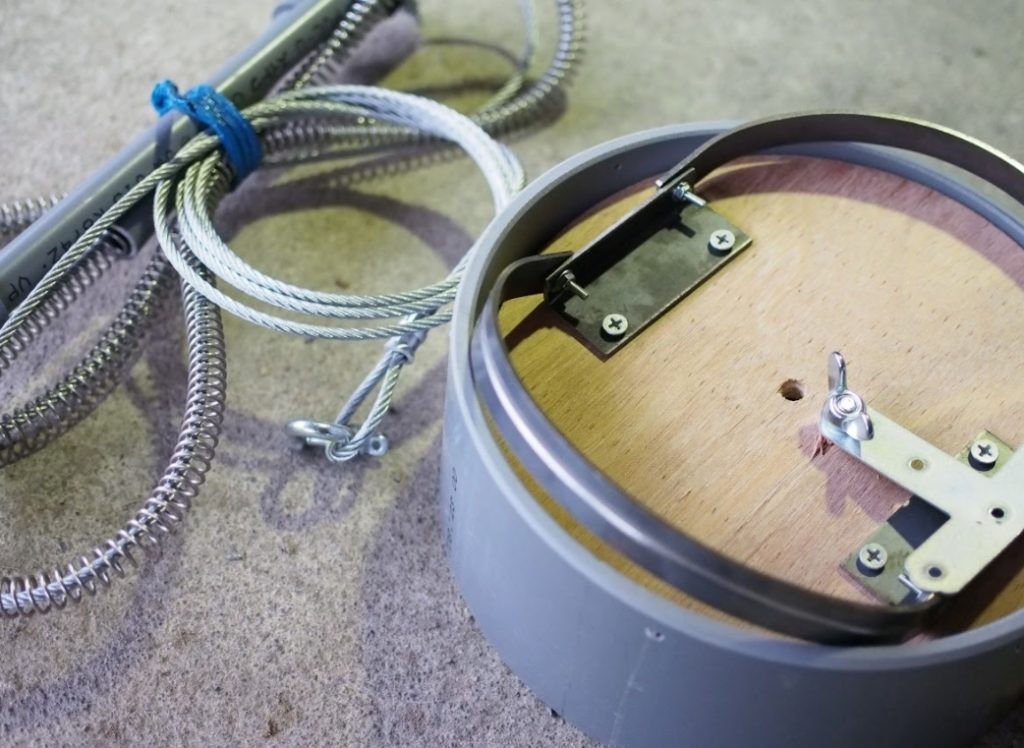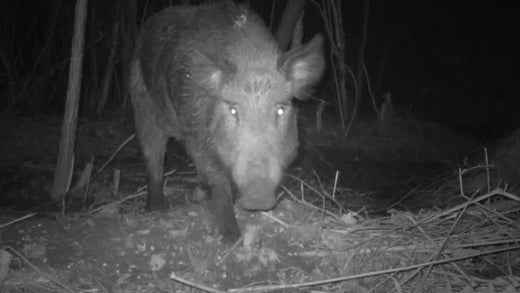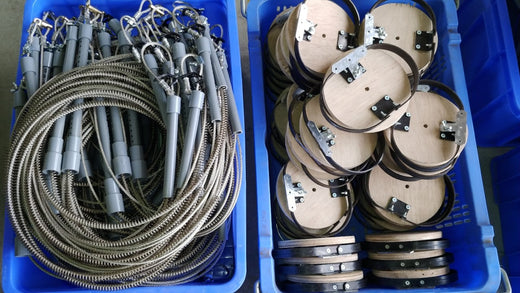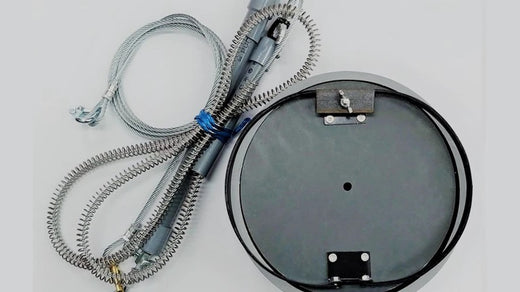A kukuri trap is a trap that is set in an animal path where prey is likely to pass, and when the prey steps into the trap with its feet, the trap is activated and literally "kukuru" the legs to capture it.
As an advantage, compared to box traps, etc., it is small and lightweight, so it is easy to install and remove, and it is inexpensive. In Miyazaki Prefecture, there is a master who has trapped 300 wild boars and deer in a year. was.
Seeing is believing, please check the performance in the video first. Suitable for both wild boar and deer. *You can see the footnotes by setting the YouTube subtitles to Japanese.
Features of the Fare Asahi Shiki Trap
Many people make their own tying traps, but the production of Fare-Asahi style tying traps requires a special machine, and the structure is such that anyone cannot easily make them. In addition, due to our unique manufacturing know-how, it is more cost effective than other tying traps (¥6,110 including 10% tax. Purchase from this page >> ).

Product composition
Fare-Asahi style tying traps consist of two parts, "A. Tread set" and "B. Spring set".
A. Footboard (Dropboard) Set
The set consists of a cut PVC pipe and a wooden footboard with a guide rail (a metal ring for winding a tying wire ring). When the prey steps on the footboard, the wire rope is tightened by the force of the spring.

Features of the FARE Asahi footboard Part 1: Adjustable load
Up to 6 toothpicks can be stuck into the PVC pipe installed in the ground. The footboard is placed on top of this toothpick, and the stepping load can be adjusted according to the number of toothpicks to be inserted.

If the number of toothpicks is small, even if the stepping load is light, the tread will fall and the trap will be activated. Conversely, if the number is large, it will not be possible to step through unless the stepping load is heavy. Roughly, 4 rods correspond to a beast weighing about 70 kg.
We can't be overconfident, but by adjusting the number of treads, we can make sure that the hounds don't fall off even if they accidentally get on the treads.

Features of FARE Asahi-style treads Part 2: Wide range of sizes
The size of the trap isAvailable in 3 sizes. You can choose according to your needs and regulatory situation.

The larger the diameter, the more likely you are to step through, but some say that the smaller diameter is easier to use because you can pinpoint your target.
*The use of tying traps with a trap diameter (minor axis) exceeding 12 cm is basically prohibited, but may be relaxed at the discretion of the governor. The rules differ from prefecture to prefecture, so please contact each municipality for details.
Features of the FARE Asahi Footboard Part 3: Easy to install
The recording time of the above video is uncut and less than one minute. Installation is completed in a short time. In fact, it takes time to dig a hole in addition to this, but even a beginner can easily install it. The fact that it doesn't take long to set up traps means that traces of people are less likely to remain, so naturally the catch rate will increase.
Features of the FARE Asahi Footboard Part 4: With safety device

When setting up a tying trap without a safety device, you may be injured by an unexpected activation of the trap. In particular, if the trap bursts on the face, it is likely to lead to a serious situation, and in some cases, blindness. This may be a familiar story for those who have been using kukuri traps for many years.

The FARE Asahi type is equipped with a safety device (T-shaped clamp) to prevent malfunction, and you can carry it with confidence even when the spring is under tension.
B. spring set
It consists of a "binding wire rope" for tying the prey's legs, a "spring" that is the driving force of the trap, and an "extension wire rope" that connects to a tree as a fulcrum.

binding wire rope
It is the part that catches the legs of the prey. Comes with tightening prevention fittings and drop-out prevention fittings. The wire has a diameter of 4 mm without oil, and we use a standard that is considered to be the best balance between softness and strength based on experience.

*The use of tying traps that do not have anti-tightening metal fittings attached to the tying part is prohibited. Also, when catching bears, wild boars, and sika deer, wire ropes with a diameter of less than 4 mm are prohibited.
spring (spring)
We use durable stainless steel. When setting the trap, push the spring all into the PVC pipe and lock it with a screw. We carefully select and use springs that are considered to be the best for tying traps.

extension wire rope
This is the fulcrum of the tying trap. Anchor it to a sturdy tree or similar object near the place where it will be set.

It has a diameter of 4 mm without oil and is made of US304 (iron mixed with 18% chromium and 8% nickel). The length is about 1.4m. A shackle (U-shaped connecting fitting) is attached to the tip, which is convenient when attaching to a tree, etc., as a support.
The extension wire rope is connected with a sarkan (gold part in the photo below) that is used to prevent twisting and tangling of the wire. It is prohibited to use tying traps that are not equipped with tying.

Reason for high catch rate
As you can see in the video, it is a flip-up type leg tie trap. It has a high capture rate because it catches above the ankle. We researched and improved every day and arrived at this specification.
How to set a trap
1. Dig a hole where you want to plant. The diameter should be 25 cm and the depth should be 10 cm.
2. Connect the extension wire rope to a sturdy tree, etc., and set the binding wire to the guide rail of the footboard. Push the spring into the PVC pipe of the spring set while pulling it with your weight.
3. Put the footboard set into the dug hole and remove the safety device.
4.The catch rate will be increased if the wire rope or the like is used to naturally cover the part that is above the ground with fallen leaves, etc., so that it cannot be seen. As a trick, when burying the PVC pipe of the tread, it is to firmly solidify the surroundings so that the PVC pipe does not become unstable.
In particular, wild boars will quickly withdraw if their feet are even slightly unstable. Let's cover the soil thin again. We recommend that you do not bury the return (sarkan) in the ground, as it will not work properly.
Once you've confirmed that you've caught prey in a trap, let's deal with it immediately. In some cases, he went to the Hunting Club to finish the job, and when he returned, he ran away, leaving only his legs behind.About purchasing products
From self-made traps to ready-made traps, a master who has tried various kukuri traps chooses the Fare-Asahi style. The reputation is very good, and there are many repeaters. Please purchase from the following page. *S, M, and L sizes are available.
>>Fare Asahi Style Trap Finished Product<<
We also have spare parts available. All parts can be supplied, so don't worry if they break.
Click here for all Kukuri Trap products >> .
The tread set can be used for a long time as long as it is not lost, but the other parts are particularly damaged by boars, so it is recommended to repair and reuse or prepare a new one.
If you have any questions, please contact us by phone, email, or through the inquiry form: Click here for inquiries >>.

 箱罠
箱罠
 くくり罠
くくり罠
 パーツ類
パーツ類
 電気柵
電気柵
 自作キット
自作キット
 防獣グッズ
防獣グッズ
 監視カメラ
監視カメラ




 box trap
box trap
 tying trap
tying trap
 enclosure trap
enclosure trap
 Prevention and avoidance goods
Prevention and avoidance goods
 electric fence
electric fence
 trap surveillance camera
trap surveillance camera
 transportation goods
transportation goods
 Trap detection sensor
Trap detection sensor
 hunting supplies
hunting supplies
 hunting books
hunting books
 Anti-bird goods
Anti-bird goods
 Agricultural materials/machinery
Agricultural materials/machinery
 boar
boar
 deer
deer
 Kyon
Kyon
 monkey
monkey
 raccoon
raccoon
 Badger
Badger
 palm civet
palm civet
 raccoon dog
raccoon dog
 nutria
nutria
 mouse or rat
mouse or rat
 Mole
Mole
 bear
bear
 pigeon
pigeon
 Crow
Crow







